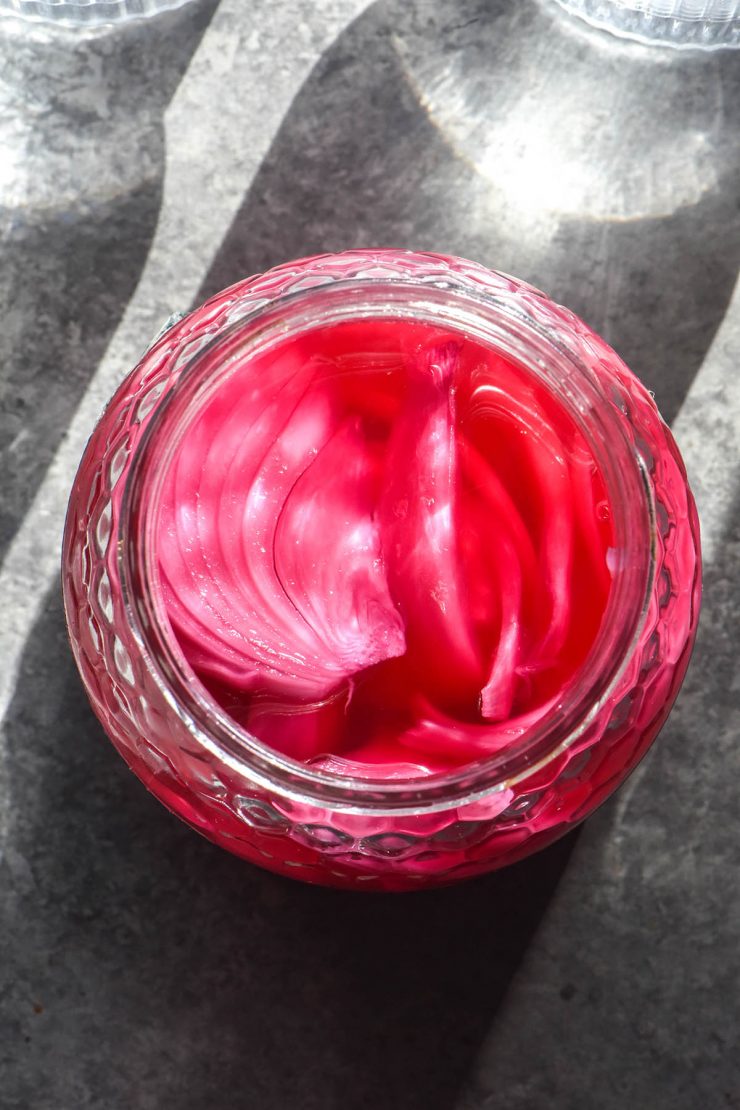
After I researched and published my low FODMAP pickled garlic recipe recently, I realised something incredible. For a number of years now, Monash has listed large pickled onions as being low FODMAP in 6-85g serves per person. I had no idea! In honour of this, I’m posting this easy recipe for low FODMAP pickled onion.
Low FODMAP pickled onion
In a similar fashion to my pickled garlic recipe, this pickled onion is not ‘special’. All plain pickled onions (with the exception of small, cocktail style onions) are low FODMAP in the right serves. However, I figured that it would be helpful to have the FODMAP information alongside the recipe.
Monash has large pickled onions listed as being low FODMAP in 60g serves. In serves exceeding 85g, pickled onion contains moderate amounts of fructans. Although 60g seems like a small quantity, it is actually quite a decent amount of pickled onion (as you’ll see in pictures below). Small cocktail onions have no low FODMAP serve, regardless of size.
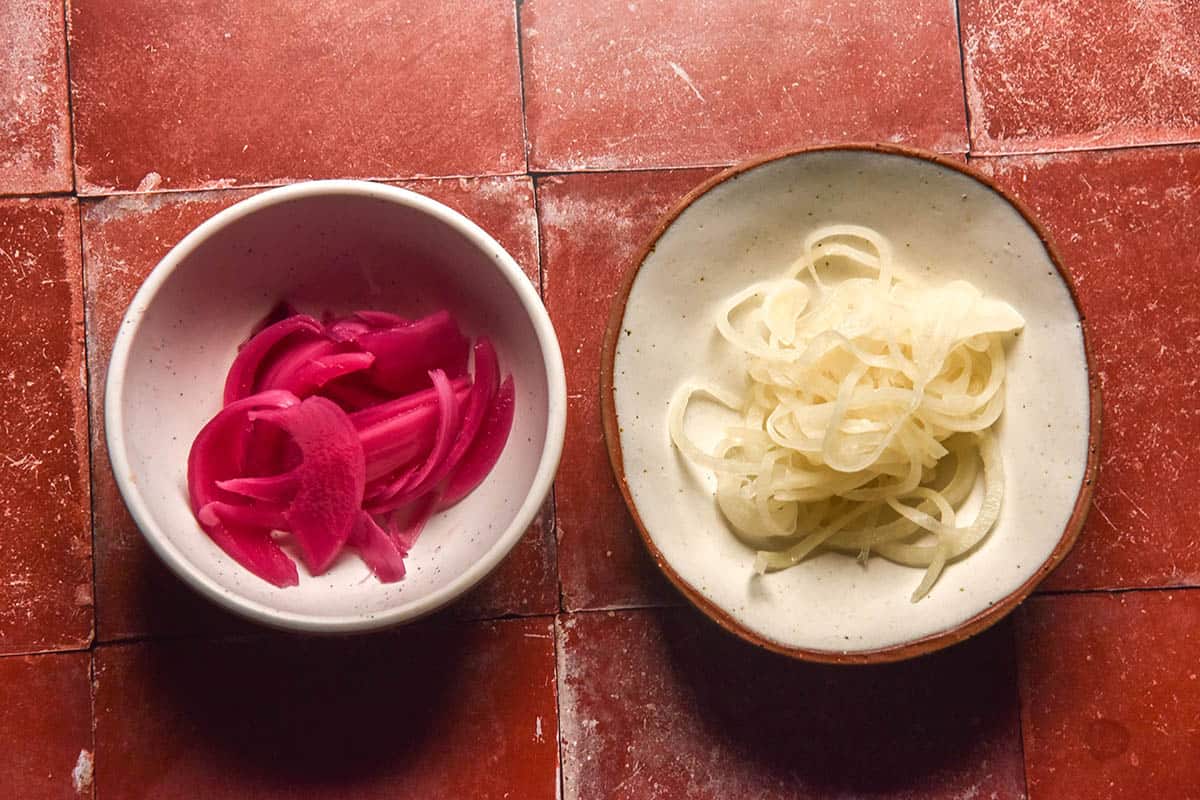
FODMAP notes
These FODMAP thresholds are current as of June 2025. They will be periodically updated to ensure they remain current.
As we have discussed, large pickled onions (not cocktail onions) are low FODMAP in 60g serves. Monash specifies that serves exceeding 85g contain moderate amounts of fructans.
They haven’t yet specified whether there is any difference between the onion varieties.
Purple onions have a low FODMAP threshold of 10g. In 13g, they contain moderate amounts of fructan. White onions have a low FODMAP threshold of 10. In 12g, they contain moderate amounts of fructans. Vidalia onions have a low FODMAP threshold of 22g. In 28g, they contain moderate amounts of fructans. Would using Vidalia onions make for an even lower FODMAP pickled onion? Only an expert can tell.
Any which way, it’s best to test your own tolerance and see what works for you. It might be that you can eat more or less than 60g.

Recipe tips
- Safe refrigerator pickling requires clean sterilised jars in the right size. For information on sterilising jars, follow these instructions.
- They also require the right percentage of vinegar and salt to keep any nasties at bay. Follow the recipe to ensure your pickles remain food safe.
- The vinegar needs to be 5% acidity. This excludes things like lemon juice (whose acidity % will vary) and fancy vinegars. For the easiest and safest results, stick to white vinegar or apple cider vinegar.
- The jar size is important because the pickles need to be fully submerged in pickling brine. Pickles exposed to air (by not being submerged in the brine) can introduce bacteria that will ruin a good batch of pickles.
- You don’t need to use pickling salt for food safety. Pickling salt is a very finely milled salt that is iodine free. Iodine can turn pickled garlic blue and some people don’t like the additives from table salt in their pickles. An easy solution is to use sea salt flakes or kosher salt. Sea salt flakes are expensive but much more common here in Australia. As I mentioned in my pickled garlic post, I found Coles Himalayan salt to be way too large of a crystal. It didn’t dissolve and left my pickled garlic with little flecks of salt in the brine.
- You can chop the onion any way you see fit. I like to slice red/purple onion into orange segment style slices, whereas I like to very finely slice Spanish onion into burger style rings. It’s all personal preference.
Can I pickle onion and garlic together?
Because I use the same brine recipe for my pickled garlic and pickled onion, I did wonder if I could pickle them together. However, I am not sure that this would work, FODMAP wise.
Pickled onion and garlic have low FODMAP thresholds because the FODMAP content appears to leech out into the brine, as it does with canned beans.
My theory (and I’d love to be disproven) is that the FODMAP of onion might leech out and be absorbed into the garlic and vice versa. This might be far fetched (I don’t know) but I figure it’s best to pickle them separately to allow their respective FODMAP contents to leech away.
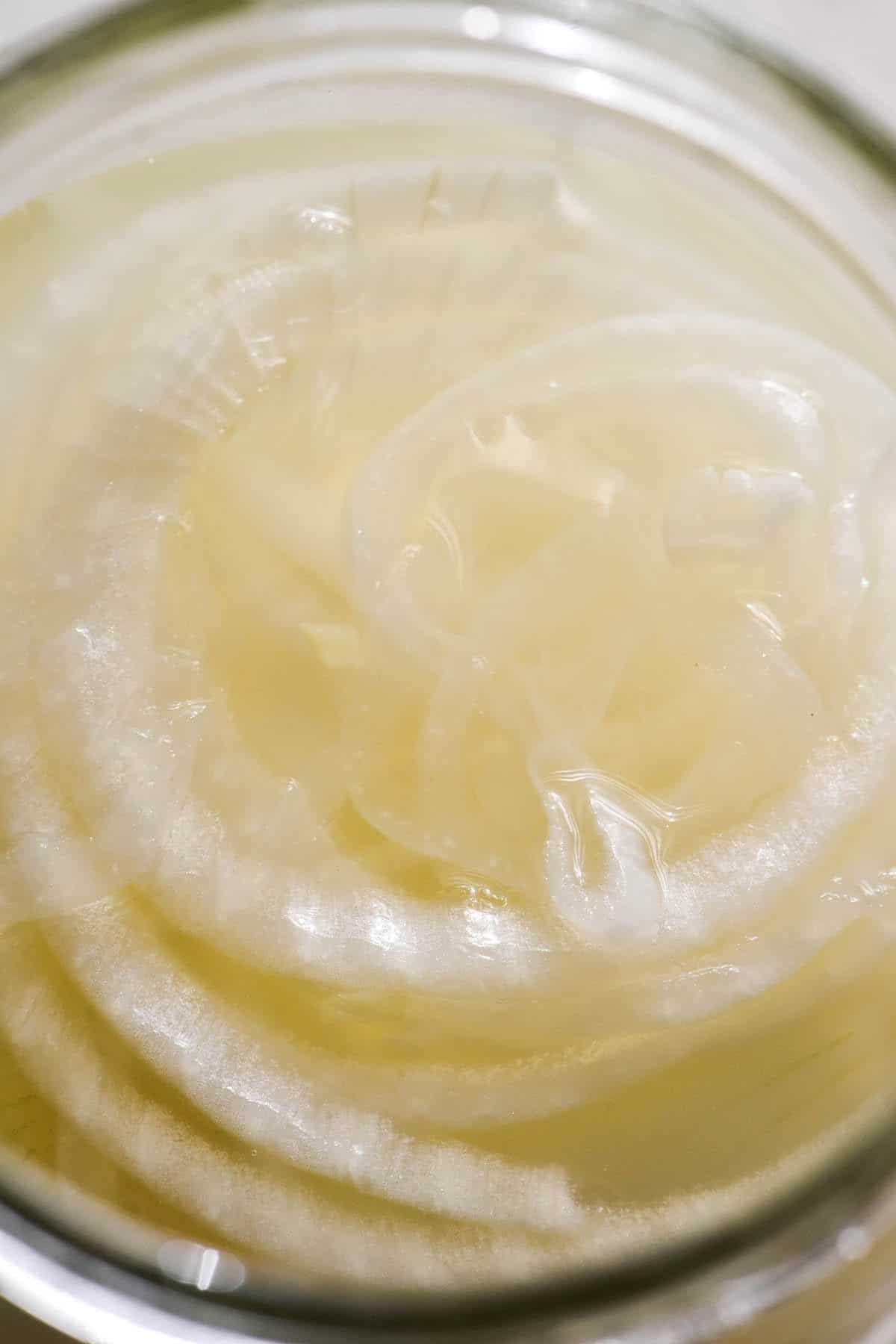
Can I use other varieties of onion?
Yes! I love pickled red onion because of how pretty it is and the subtle, slightly sweet taste. If you would prefer to use other onions, you are more than welcome. As you can see from the photos, I have also tested brown onions which worked wonderfully. They had a gorgeous crispiness that I absolutely loved.
Can I use lime juice instead of vinegar?
Monash hasn’t provided any information as to whether a quick pickle is low FODMAP or whether it needs to be a refrigerator pickle. A quick pickle is when you gently cook your pickle on the stove and then serve immediately, whereas a refrigerator pickle keeps in brine (in the fridge) for 2-3 weeks. I daresay it needs to be a refrigerator pickle to allow it time for the FODMAPs to leech out, however.
Refrigerator pickles require vinegar of at least 5% acidity and the right ratio of salt. These work together to pickle the onion but also to keep any nasties at bay.
Lime juice, although delicious, is a bit of a wildcard in terms of its acidity percentage. It might be more than 5% or it might be less; as far as I know there’s no easy way of knowing. As such, I can’t recommend this substitute.
However! You can absolutely experiment with adding lime juice in addition to the vinegar. You might need add some extra sugar to suit.
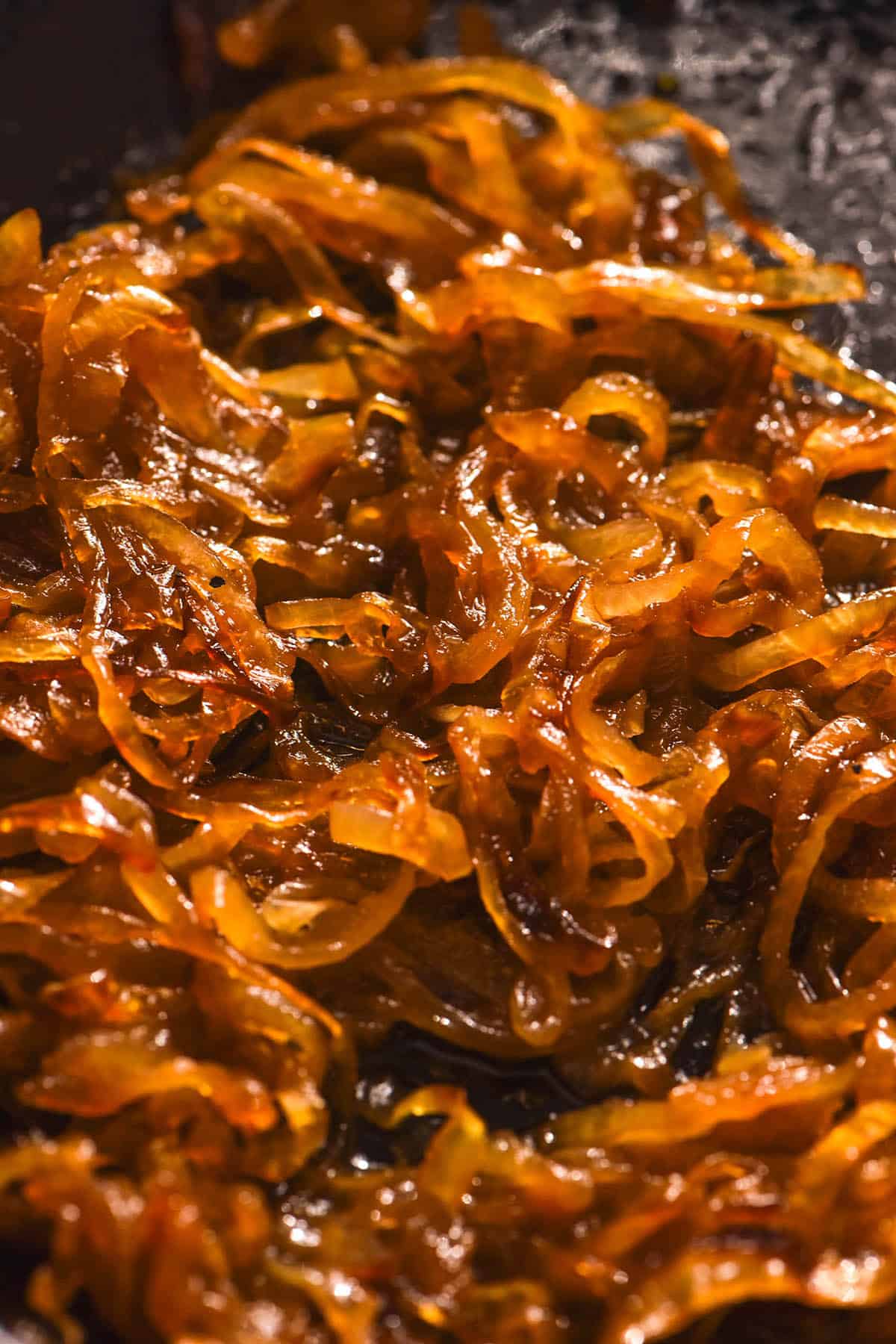
Do I need to add sugar to pickled onion?
No, you don’t. Pickled onion recipes sometime use a small (or not so small) amount of sugar for taste purposes. Unlike vinegar and salt, sugar contributes nothing to the stability of your pickle. Although my recipe only uses a small amount of sugar, you can absolutely omit it if you wish.
What can I do with these low FODMAP pickled onions?
The sky is the limit! Although they are definitely more acidic than regular onions, I find you can use them anywhere you would normally. Because we often add acidity to balance out dishes, it isn’t an offensive addition to a dish.
I recommend trying them:
- To make low FODMAP onion rings
- To make low FODMAP caramelised onion
- To make a low FODMAP mushroom and caramelised onion toastie
- To make low FODMAP French onion dip
- To make low FODMAP crispy fried onions
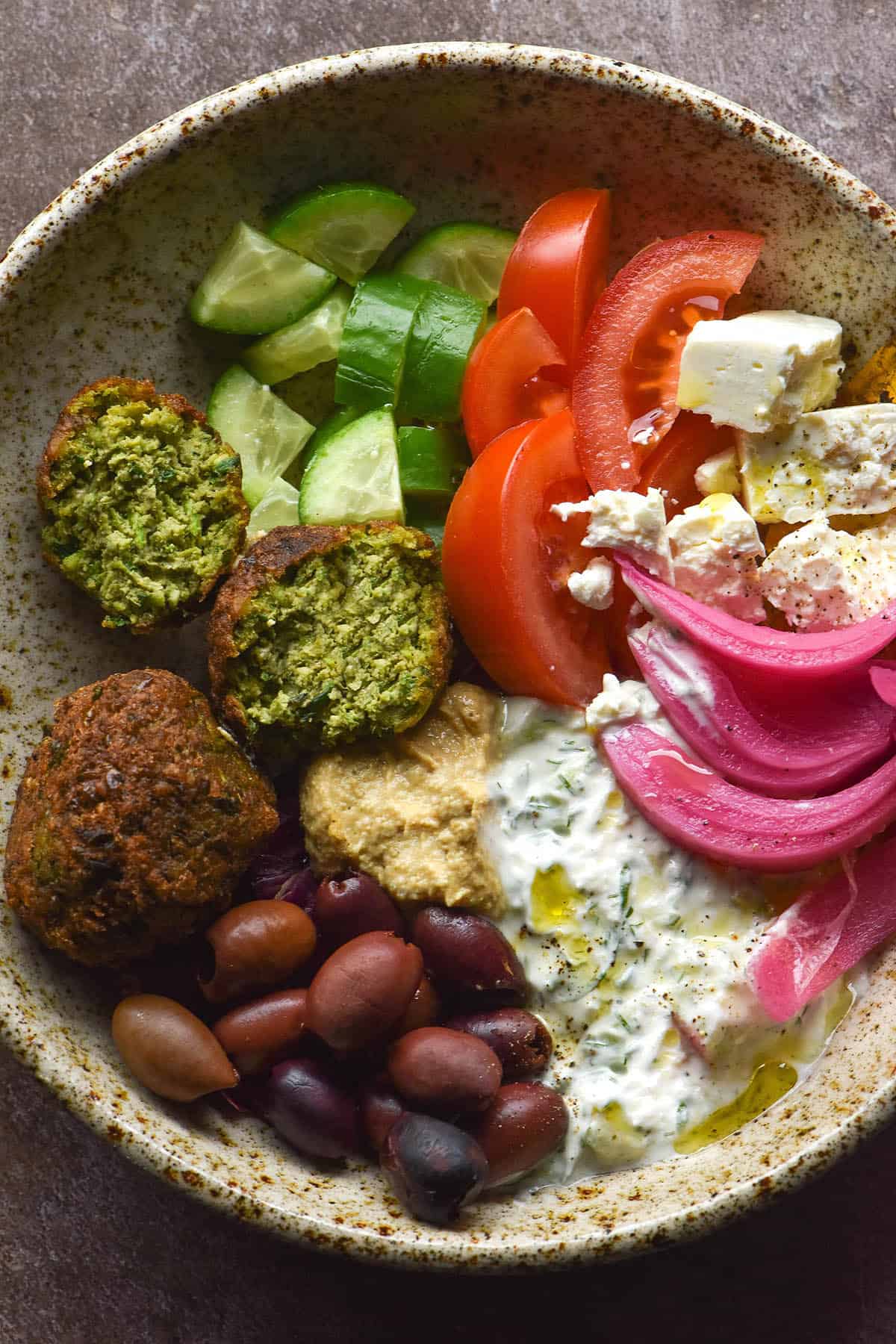
Low FODMAP recipes to serve with your low FODMAP pickled onion
- Low FODMAP falafel bowls
- Low FODMAP vegan chilli
- Gluten free, xanthan gum free bagels (topped with lactose free cream cheese)
- Low FODMAP vegan shredded tofu tacos
- Low FODMAP vegetarian or vegan enchiladas
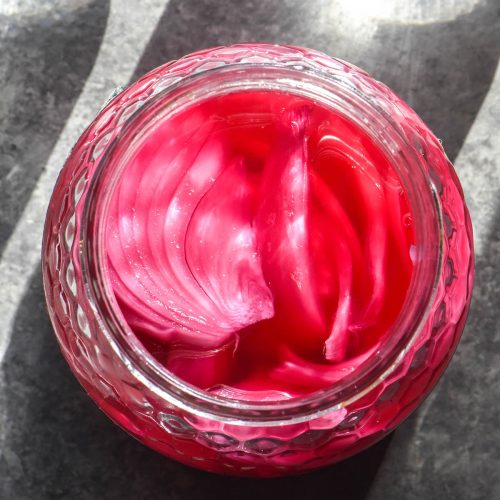
Low FODMAP pickled onions
Ingredients
- 350g purple/red, Spanish or white onion, skin removed (around 1 1/2 large onions)
- 180ml (3/4 cup)* white or apple cider vinegar (see notes)
- 180ml (3/4 cup)* water (purified if you live in an area with poor water quality)
- 15-20g fine salt (see notes)
- 20g (1 tablespoon)* white sugar (optional)
Instructions
- Wash and sterilise your 750ml – 1 litre glass jar (see notes for instructions).
- Remove the skin from your onions and slice them in you desired shape. I like thicker pieces for purple onion and thin slices for Spanish onion, but that's just me.
- Place the vinegar, water and fine salt in a medium pot over a medium heat. Cook until the salt has dissolved.
- You can pack the onion, raw, into the glass jar and then pour over the brine, if you like. I prefer to cook the onion in the brine for a minute or two. This makes the onion softer and more flexible, which makes it easier to arrange in the jar. In the case of purple onion, it also seems to make the colour more vibrant once pickled.
- Pour over the brine, ensuring the onion is covered with brine. Screw the lid on and place in the fridge. You can assess your tolerance to onion by eating a little day by day – Monash doesn't specify how long it needs to be pickled before it becomes low FODMAP.
- Always store pickles in the fridge and submerged in brine and eat within 2-3 weeks.
Notes
- Vinegar needs to be at least 5% acidity to ensure food safety. White vinegar and apple cider vinegar are those that fit this bill.
- Fine, non-iodised salt is best for making pickles. Chunky salts struggle to dissolve in the brine. I use sea salt flakes in Australia – more expensive and a bit wasteful but it can be difficult to kind kosher salt here.
- You can use table salt in your pickles but it may result in a cloudy brine.
- Jar size does matter – pickles need to be completely submerged in brine. I use Mayvers Peanut butter jars and large honey jars here in Australia. They are 750g – 1kg in size. This fits the pickle recipe perfectly.
- Monash doesn’t specify how long onions need to be pickled before they become low FODMAP or whether they are low FODMAP immediately after pickling. Assess your own tolerance and see what works for you.

Hi, I noticed that in your Pickled Garlic recipe you had to heat the jar in the oven, but you don’t do that with this recipe. Why is this?
Hi Kandace! You do need to sterilise the jar for this recipe as in step 1. I left the method of sterilising up to the user but there is a link to instructions in the ‘recipe notes’ section above the recipe card.
Prepared garlic has more safety considerations when compared to pickled onion which is why I explicitly listed the sterilising method in the recipe card.
Just want to make absolutely sure people follow all safety precautions 🙂
Quick Q before I start hearing my ingredients; in step 3 it says to heat together until the water is dissolved. Is that a typo and it’s supposed to say salt? And if ‘water’ is correct how do we know when that is dissolved(evaporated?) ? Thank you! Am just waiting on this clarification before I start heating it up. I’m tragically excited to be making this! ????
Hi Paula! So sorry, definitely a typo haha. It is supposed to say wait until the salt is dissolved 🙂 Thanks for letting me know, I will change it now!